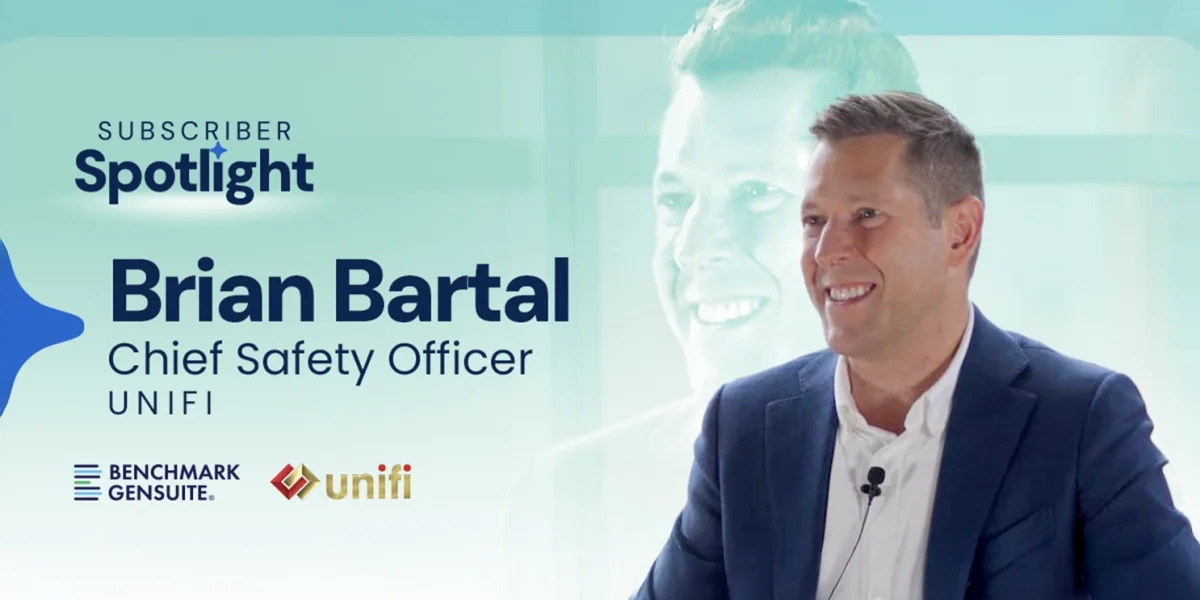Building Aviation Safety Culture Through EHS Software and a Personal Commitment to Safety
Safety is more than compliance—it’s about people. In this Q&A, we sit down with Brian Bartal, Chief Safety Officer at Unifi, to hear his perspective on how aviation safety shaped his calling, the impact EHS professionals can make, and how technology, including advanced EHS software, is reshaping reporting, analytics, and predictive risk management.
How Did You Begin Your Career in Aviation Safety and EHS?
Brian: I’m the Chief Safety Officer at Unifi. I’ve been in aviation and logistics for 25 years, and safety is ingrained in every aspect of aviation. I’ve been in a dedicated safety and compliance function for about 13 or 14 years now. I ran a regional airline operations for a little over a decade. I used to jokingly say I had more safety incidents than anyone else, but I also ran one of the largest ramp operations. That meant a lot of exposure, which helped. I really consider myself an operator who strives to operate at a high standard. Safety is about consistently executing to the standard. It was a natural fit to be in a role focused on consistent, high-level execution—safety is one of the outputs of that.
What Personal Experience Highlighted the Role of EHS Professionals?
Brian: Probably the most impactful moment for me was while volunteering at my son’s elementary school. There was a program called Amazing Shake, where kids learn to shake hands, engage, and have conversations with adults. I was a judge for the “work the room” challenge, where kids had to hold an adult conversation.
One student asked what I did for work. I didn’t want to just say “safety,” so I told him I worked in the airline business. He shared a story about his father, who worked for a major airline. On his last day, his father was injured. The boy teared up as he told me about it.
That really struck me. Every serious incident that happens to our employees crosses my desk, and after a while, you can become numb and focus only on data and trends. That boy’s story renewed the human connection for me. It reminded me that every injury impacts not just the individual but their family and loved ones. It was a realization of why my job is important and the value I can bring.
How Have EHS Software and Technology Strengthened Unifi’s Safety Reporting Culture?
Brian: When Unifi became a private company, we had to build our own systems and culture. From an EHS perspective, fair and just culture is one of the most important aspects. We looked at tools like behavioral decision trees to integrate into investigations, and also focused on system tools like hazard concern reporting. For employees who come from businesses without open reporting cultures, it was important they felt safe doing so.
We partnered with Benchmark Gensuite and configured the Hazard Concern tool so employees could access it outside our ecosystem, de-identify if they wanted, and submit concerns. We’ve seen a hundredfold increase in reporting.
Now we’re also working on recognition reporting. Peer-to-peer recognition is essentially a hazard or concern in disguise. A colleague can notice something great and report it, and we even pay out cash rewards. It made sense to link recognition and hazard reporting into a single data set.
How Did You Simplify EHS Incident Reporting for Frontline Workers?
Brian: Hazard and concern reporting is something everyone wants, but it’s challenging to make it part of the culture. Our employees had to jump through hoops to make a report. We partnered with Benchmark Gensuite and introduced single sign-on so employees could report easily within our system. Then we went further and created a forward-facing portal so individuals could report without any login. That allowed us to use QR codes. Now, QR codes are posted in break rooms, on safety policies, and in daily briefings. Employees can scan, and the form pops up. It’s simple and intuitive, and participation has grown.
What Safety KPIs and Risk Metrics Does Unifi Prioritize in EHS?
Brian: Like most organizations, we track OSHA recordables and lost time. As an aviation services provider, we also track two aviation-specific KPIs: aircraft ground damage and weight-and-balance discrepancies.
We also deal with large amounts of chemicals and operate in a high-threat security environment, so our view of security risk is different. To make sense of it, we added event leveling to our reporting. We set up a basic risk matrix with thresholds for different levels of risk—A, B, C, and D. Employees use a pop-up guide in the incident template to assess risk level.
Since our business has grown fourfold in five years, we’re looking at risk leveling as a rate based on revenue. That will be a new favorite KPI—it scales with the business and cuts across silos like safety, security, environmental, and operational risk. It gives us a holistic view.
How Does Unifi Use Dashboards and EHS Analytics to Improve Safety?
Brian: We collect a tremendous amount of data. Last year, we had over 580,000 observations, with about a 10% finding rate. Every finding is a coaching opportunity, and each one we address is an incident prevented.
We had dashboards, but not the ones we needed to measure sub-organizations or business areas effectively. We worked with Benchmark Gensuite and Tableau, and with Gladys—an expert who quickly built out robust dashboards. It has made a huge difference in holding business units and leaders accountable.
How Is Predictive Analytics Used to Prevent Risk in Aviation Safety?
Brian: Iterative learning is key. We use machine learning, which some call “old AI,” but it’s highly effective for making accurate predictions. Our environment is always changing—turnover rates, climate change, and other factors all shift over time. We needed a model that would not only predict risk but also retrain itself.
Every Sunday at midnight, our model reprocesses data from incidents, using 508 data points per case. It checks whether the new model makes better predictions. If it does, it replaces the old one. That way, each week we’re applying the most accurate model for predicting where risk exists in our business.
Final Reflections on EHS, Aviation Safety, and Culture of Care
Brian’s perspective highlights that safety isn’t just about compliance or checklists—it’s about people, culture, and continuous improvement. From creating easier ways for employees to report concerns to building predictive models that evolve weekly, Unifi’s approach shows how technology and human commitment come together to keep people safe.
Key Takeaways on EHS Software in Aviation
- Unifi scaled hazard reporting 100x using Benchmark Gensuite tools.
- Predictive risk models retrain weekly using over 500 data points.
- Mobile QR-code reporting removed barriers to frontline participation.
- EHS KPIs now scale with revenue, integrating safety with enterprise strategy.
To learn more about Benchmark Gensuite supports the Aerospace and Aviation organizations, visit our industry page

